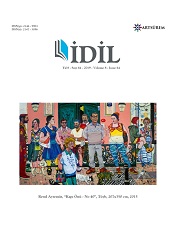Ernst Neizvestny’nin Figüratif Heykellerinde Deformasyon
Deformation of Ernst Neizvestny's Figurative Sculptures
Author(s): Oğuz YurttadurSubject(s): Visual Arts, Post-War period (1950 - 1989), History of Art
Published by: Sanat ve Dil Araştırmaları Enstitüsü
Keywords: Ernst Neizvestny; sculpture; deformation;
Summary/Abstract: Ernst Neizvestny is an important artist who made a name for himself with his interesting life story and opposing attitudes after the Stalin regime. In the 1960s and 1970s, the artist left a deep impression on the history of Soviet Union art with a very rigid and opposite stance to Soviet Ideology. Deformed figures, hands and body images are widely used in his works. In this respect, the expressionist-constructivism approach and the plastic formation of his works emerges as the most distinctive feature of Neizvestny that distinguishes it from other sculptors. The artist has both contradictions and a smooth narrative style in his works. Just like the concept of ying-yang, good in evil, bad in good. The works are blends of pure reality and deformation of the body. Each space is the binding and stabilizing part of another. The deformed states of human body parts have become a whole and form a talking image. "Everything is form, life is a form," Balzac said. If we look at the art field from this window; In art, everything can be said to consist of forms formed by deformation (Turani, 1985:102). The figures in Neizvestny's sculptures were also blended with dramatic expression and shaped in the context of deformation. In this article, Ernst Neizvestny’s statues are analyzed in the figure-deformation relationship window.
Journal: İdil Sanat ve Dil Dergisi
- Issue Year: 8/2019
- Issue No: 64
- Page Range: 1695-1701
- Page Count: 7
- Language: Turkish

